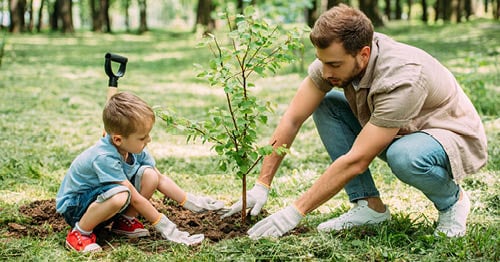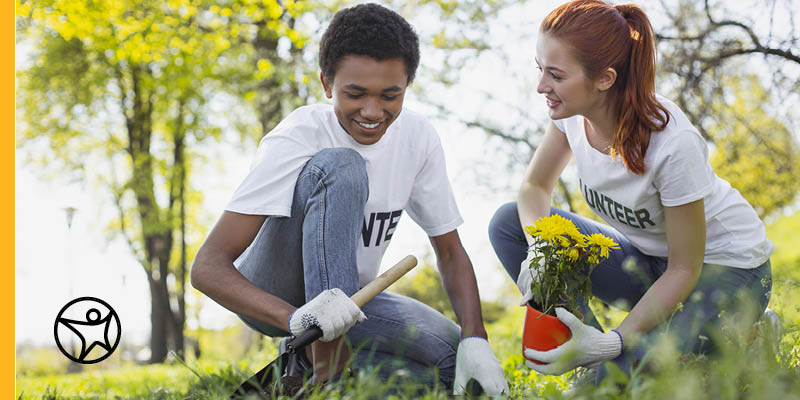Can You Change Your Career Path in High School?
by Phoebe Brown
byJulie Hersum
6 min to readWondering what to do on Earth Day to help your student become more aware of the environment and sustainability? Help them learn more about earth science while making a positive impact in their community with some meaningful Earth Day activities geared for families and students of all ages.
Keep reading to discover the history of Earth Day and find inspiration for celebrating it with your family this year.
Earth Day is an annual event in the U.S. dedicated to raising awareness about the importance of sustainability and environmental stewardship to our planet. The history of Earth Day stems back to 1970, when 20 million Americans were inspired to demonstrate against the environmental impacts of 150 years of industrial development. Thousands of universities organized protests against the deterioration of the earth from oil spills, pollution, the loss of wilderness, and more, according to earthday.org.
Later in 1990, Earth Day went global with a campaign to drive recycling efforts around the world. Today, Earth Day is widely known as a day of action to promote change in both human behavior and policies for a cleaner world.
By engaging in hands-on activities together—like planting trees, making a commitment to reduce waste, or cleaning up a park—kids see firsthand how small actions can make a big impact. These are also opportunities to spark curiosity, have meaningful conversations about nature, and create lasting memories as a family.
Gardening activities can make some of the most rewarding, hands-on Earth Day activities for students.
Have your learner plant a flower or veggie seed in a cup to take care of. It just might become a few pots of herbs in your kitchen, flowers on your front porch, or even a tree or row of vegetables in your yard.
As their plant germinates and grows, discuss how plants start as tiny seeds and use nutrients from the soil, water, and sunlight to turn into a plant.
Taking a hike in nature is a fantastic Earth Day activity for getting young learners outside, engaging their senses, and helping them connect with the natural world in a fun and educational way.
Choose a location, such as a park or nature trail. While this activity could be done in your backyard or a local greenspace, try to make a dedicated trip out to a forest, beach, lake, mountain or other space to explore a new environment.
Before heading out, create a custom scavenger hunt checklist of items you and your child are likely to see, smell, or hear (not touch!) while they are there.
Your list might include:

For older kids, look into volunteer opportunities to clean up a local park. You can even make it a fun competition or litter cleanup challenge to collect the most trash.
Parks can be high-traffic areas with plenty of discarded trash. Picking it up makes a difference and may encourage others to be responsible, too. Remember to have students wear gloves and safely dispose of debris in trash bags. And don’t forget to recycle any bottles or cans you may find!
Encourage kids to participate in a no-waste meal challenge by helping you plan a full week of meals while focusing on reducing waste, composting, using sustainable ingredients with minimal packaging, and making smart food choices.
Before planning, have students:
Keep in mind:
Combine several Earth Day activities for kids and create an entire day of outdoor learning. Your student can enjoy a full day dedicated to celebrating the earth and being outside.
For example, try birding:
Older kids may enjoy calculating their own ecological footprint. Start by having them reflect on your family’s habits and take the Footprint Calculator Quiz from Global Footprint Network.
Talk about each question and brainstorm a few easy actions you can take to lower your footprint.
Demonstrate sustainability in fashion—with a clothing swap!
Instead of throwing away old clothes and buying new, students trade items they no longer need or want with their friends and family. Extending the life of clothing by swapping perfectly good items with others helps reduce fast fashion, promotes sustainability, encourages students to reuse and reduce textile waste.
This Earth Day activity is a great way to encourage critical thinking, public speaking, and a deeper understanding of pressing environmental challenges, such as pollution or deforestation.
Students might give their presentations to friends, family members, a social media audience, or even a local community group, library, or club.
Just because Earth Day only lasts for one day doesn’t mean your family can’t take part in Earth Day activities throughout the year!
Connections Academy's online learning model gives families the flexibility and added time for participating in meaningful outdoor activities in your community that help our planet and can foster a lifelong love of nature.
Learn more about Connections Academy® and how you can personalize your child’s learning in the way that best supports your child's education journey.
